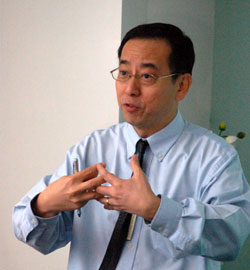Last week, we ran a report on CWT (CWT: Asia’s No.1 freight forwarder sees higher NVOCC demand). Below is a summary of opportunities in telecommunications, healthcare and marine transportation as discussed by 3 other participating listcos.
Sinotel

Sinotel Vice President of Corporate Communications Ben Ng. Photo by Sim Kih
Sinotel’s core business is providing its proprietary system for enhancing wireless telecommunication networks. For example, its multi-carrier wireless system enables mobile phones to be used in a building’s lift where there is usually no reception.
Its vice president of corporate communications and investor relations, Mr Ben Ng, was very bullish about China’s telco sector when he spoke to about 30 investors who crowded into Financial PR’s
conference room last week.
In Jan 2009, China officially allowed its telecos to provide 3G services, spurring demand for related network infrastructure.
As a result, China Unicom, which uses Sinotel’s services, has earmarked a whopping Rmb 95 billion to upgrade its facilities in 2009.
Just last week, Sinotel announced that it won six new orders worth Rmb 32.9 million to provide network optimization solutions for China Unicom’s branches in Beijing, Chongqing, Guangxi, Hebei, Shaanxi and Jiangsu.
Thomson Medical

Thomson CEO Allan Yeo. Photo by Sim Kih
Thomson Medical is Singapore’s leading women’s and children’s hospital. In healthcare jargon, it specializes in primary, secondary and tertiary obstetrics, gynecology and pediatrics.
Its CEO, Allan Yeo, was excited about its plan to expand in Vietnam. His strategy is to target geographic areas like Vietnam and Malaysia where there is a severe shortage of hospital beds for child delivery.
He foresees strong demand as Vietnam has a large population of 85 million and 60%-65% are within their childbearing years of 30 to 65.
Thomson is building what will be Vietnam's largest and most well-equipped private hospital for women and children healthcare services – the Hanh Phuc International Women and Children Hospital.
The hospital is located in one of Vietnam’s most prosperous provinces, Binh Duong, and is expected to commence operations next year.
Marco Polo Marine

Marco Polo's shipyard has become more developed since its IPO days (above).
Not only does Marco Polo Marine have one of the largest shipyards on Batam, it is also one of the most efficient tug and barge operators in Southeast Asia.
Its fleet of 18 pairs of tugs and barges contributed 61% to its 1Q09 revenues for the period ended 31 Dec 2008.
Shipbuilding demand may have plunged, but its CEO Sean Lee is confident that demand for the company's ship chartering services will remain strong.
Here's why.
Firstly, Marco Polo has a niche in the transshipment of coal mined in Indonesia to third-party vessel operators for their onward transportation to energy power plants. And Indonesia is the world’s largest supplier of thermal coal, which is used to generate about 40% of the world’s electricity.
Secondly, Singapore’s flurry of construction projects, which include S$20 billion of public sector spending in 2009 as well as the integrated resorts, will keep demand for sand strong. Marco Polo’s tugs and barges are deployed in transporting sand from Myanmar and Vietnam to Singapore.
The integrated shipyard group intends to expand its fleet to 24 pairs of tugs and barges by the end of 2009.
Related story: MARCO POLO: From newbuilding to shiprepair


